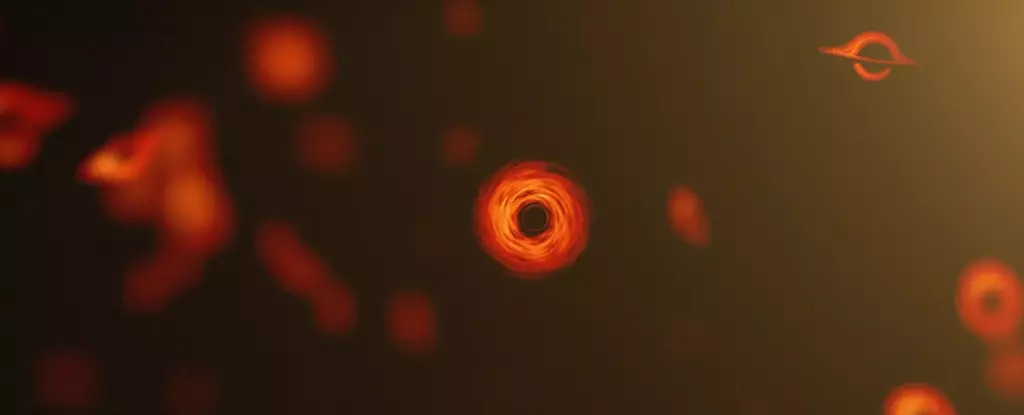The concept of primordial black holes (PBHs) captures the imagination of physicists and astronomers alike. These theoretical constructs are posited to have formed in the universe’s infancy, possibly only moments after the Big Bang. According to scientific theories, fluctuations in energy density during the early universe could have led to the collapse of localized regions of subatomic matter under gravity, resulting in the creation of black holes much smaller than their stellar counterparts. With the accelerating interest in PBHs, researchers are now considering their potential roles in cosmic phenomena, particularly regarding dark matter and gravitational waves, while seeking innovative methods for their detection.
Notably, recent research led by physicists De-Chang Dai and Dejan Stojkovic has introduced ground-breaking strategies for identifying these elusive entities. The current discourse is that PBHs may exist within the interiors of various celestial bodies, such as neutron stars and dwarf stars. These small black holes could consume the material around them, effectively hollowing out their hosts. This innovative viewpoint highlights not only the properties of PBHs but also provides new pathways for their discovery through indirect observations.
For instance, the researchers propose looking inside planets and asteroids for PBHs. If these bodies have a solid crust surrounding a liquid core, a passing PBH would devour the liquid mass, leading to a void while leaving the outer structure intact—an idea that could revolutionize our approach to identifying PBHs.
Dai and Stojkovic meticulously analyzed the gravitational forces that a small PBH would exert on the surrounding materials. Their exploratory calculations compared these forces to the compressive strengths of various geological components, such as silicate minerals and metals, which constitute celestial bodies. They highlighted that materials like granite could maintain a hollow form up to a significant scale given the right conditions, demonstrating the feasibility of detecting PBHs in their proposed contexts.
This nuanced understanding of gravitational stress offers a promising angle from which to methodically search for signs of PBHs. By targeting candidate celestial bodies in our solar system and assessing their density profiles, scientists could identify anomalies indicative of hollow structures, thus providing critical clues to the potential presence of PBHs.
To further bolster their research, Dai and Stojkovic suggested examining microtunnels left by PBHs traversing solid materials. These tiny, linear vacuums would potentially be detectable in materials commonly found on Earth, such as glass and metal. They emphasized the importance of isolating sensors to monitor any shifts in material properties that could signify a passing PBH, similar to techniques already employed in neutrino detection.
Encouragingly, the physicists noted that, despite the anticipated low rate of PBH interactions, the cost-effectiveness of such experiments allows for a large-scale search effort with manageable resources. They posit that uncovering definitive evidence of PBHs could yield fundamental insights into the fabric of cosmic evolution.
The PBH hypothesis is not a novel proposition; it traces back to the influential work of scientists like Igor Novikov and Yakov Zeldovich in the 1960s, and it has been enhanced by contributions from eminent figures such as Stephen Hawking. Intriguingly, Hawking’s research on the evaporation of black holes has ramifications on our understanding of PBHs, suggesting that smaller black holes could evaporate more rapidly than larger counterparts.
In recent years, renewed interest in PBHs as dark matter candidates has prompted scientific inquiry into their signatures, including their potential radiation of gamma rays. As Dai aptly points out, detecting gamma-ray emissions could serve as circumstantial evidence for the presence of primordial black holes in our galactic neighborhood.
The exploration of primordial black holes exemplifies the spirit of scientific discovery, merging theoretical insights with empirical investigation. While definitive proof of their existence remains elusive, the ongoing research is reshaping our understanding of dark matter and gravitational phenomena in the universe. Through innovative methodologies and a strategic approach to detection, scientists are positioning themselves to unravel one of the cosmos’s most enduring mysteries—ushering in an era of unprecedented knowledge about the origins and composition of our universe.
In this exciting quest, every experiment, however small, carries the potential for monumental discoveries that could redefine our grasp of cosmic history. As the search for primordial black holes unfolds, it invites both skepticism and wonder, propelling the scientific community to tackle the profound enigmas that persist in the vastness of space.

